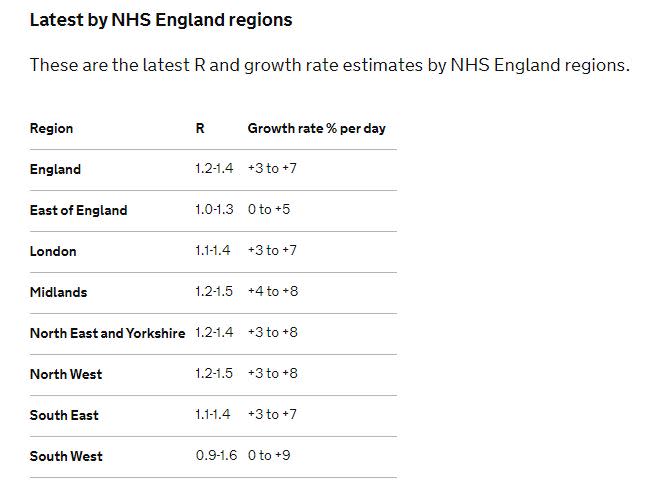Coronavirus: 'Widespread growth' across UK as R rate jumps to as high as 1.4

The reproduction rate of coronavirus infection in the UK has jumped to between 1.1 and 1.4.
Experts on the government's Scientific Advisory Group for Emergencies (SAGE) published the latest figures on Friday.
“It is SAGE’s expert view... that this week’s estimates are reliable, and that there is widespread growth of the epidemic across the country,” the government website reads.
An R number between 1.1 and 1.4 means that on average every 10 people infected will infect between 11 and 14 other people.
The rate last week was between 0.9-1.1.
The updated growth rate of between +2% and +7% means the number of new infections is growing by 2% to 7% every day.
Figures are based on epidemiological data such as hospital admissions, ICU admissions and deaths, meaning it takes up to three weeks for changes in the spread of disease to be reflected in the estimates due to the time delay between initial infection and the need for hospital care.

Figures also published on Friday by the Office for National Statistics revealed that in England there were 6,000 new infections per day in the week leading up to 10 September.
The ONS website said: “During the most recent week of the study, we estimate that 59,800 people in England had the coronavirus (COVID-19). This equates to...around 1 in 900 people.
The ONS figures are taken from tests in the community and do not include people staying in hospitals, care homes or other institutional settings.
The news comes as the government faces fierce criticism that the test and trace programme designed to prevent the spread of coronavirus is failing.
On Friday Matt Hancock announced new restrictions including curfews on pubs and restaurants and a ban on socialising outside of households across parts of the north west, Midlands and west Yorkshire, from Tuesday.
The health secretary told Times Radio: “The seriousness of the decisions we take can't be overestimated and we're making judgments about how to protect the health of the nation and how to save tens of thousands of lives whilst balancing that with the enormous social and economic and health impacts of the measures that we have to take.
“These are huge decisions and very weighty ones and so it's hugely understandable that the people making them should be taking them extremely seriously.”
The lack of availability of coronavirus tests nationwide has led some to suggest that the true figure of new infections could be higher.
NHS Test and Trace chief Dido Harding admitted on Thursday that up to 75% of people who want a coronavirus test are unable to get one.
In England, only the region of the south west has a lower R rate base of below 1, but its estimate is between .9 and 1.6 - the highest upper level.

In the south east, London, and the north east and Yorkshire, the rate rate could be as high as 1.4, and in the Midlands and north west is could be as high as 1.5.
On Thursday a study showed that Swindon is the only place in the UK that is definitely seeing a decrease in coronavirus numbers with most places seeing their infections rising daily.
An interactive map that uses mathematical modelling to predict how likely a local authority is suffering from an increase in coronavirus infections showed almost every area of the UK is seeing their case numbers rise.

The map - created by a team at Imperial College London and updated weekly - indicates that the direction in 14 local authorities is unclear with the rest of the UK either likely or definitely seeing an increase.
In total across the UK there have been 382,000 recorded cases of coronavirus and 41,705 deaths within 28 days of a positive test. These figures were correct as of Friday afternoon.
Coronavirus: what happened today
Click here to sign up to the latest news, advice and information with our daily Catch-up newsletter


